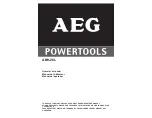
page 5
To reduce the risk of injury, wear safety
goggles or glasses with side shields.
Selecting drill or rotary hammer action (Fig. 4)
OPERATION
Fig. 4
Fig. 5
Forward/Lock/Reverse Switch
WARNING!
1.
To select
rotation only
, rotate the shift knob 180° in the direction of
the double arrow so that the tab portion of the knob points toward
the symbol. Do not shift the tool when it is running or coasting
to a stop.
When drilling in wood or steel, shift knob to Rotation Only and use
chuck adapter kit. Refer to your
MILWAUKEE catalog for part infor-
mation.
2.
To select
rotary hammering
, rotate the shift knob 180° in the
direction of the double arrow so that the tab portion of the knob
points toward the symbol.
NOTE:
To engage the hammering mechanism, maintain pressure on
the bit. When pressure on the bit is released, the hammering action
will stop.
Using the forward/lock/reverse switch (Fig. 5)
1.
For
forward
(clockwise) rotation, hold the tool with the nose point-
ing away from you and push the forward/lock/reverse switch to the
left.
2.
To
lock
the trigger, push the forward/lock/reverse switch to the
center position as shown. The trigger will not work while the for-
ward/lock/reverse switch is in the locked position. Always lock the
trigger and remove the battery pack before performing maintenance,
changing accessories and any time the tool is not in use.
3.
For
reverse
(counterclockwise) rotation, hold the tool with the
nose pointing away from you and push the forward/lock/reverse
switch to the right. To prevent damage to the gears and motor, allow
the tool to come to a full stop before reversing.
Starting, stopping and controlling speed
1.
To
start
the tool, pull the trigger.
2.
To vary the drilling speed, simply increase or decrease pressure on
the trigger. The further the trigger is pulled, the greater the speed.
3.
To
stop
the tool, release the trigger.
Rotary hammering
Position the tool, grasp the handles firmly and pull the trigger. Always use
the side handle. Hold the tool securely and maintain control. Use only
enough pressure to hold the tool in place and to prevent the tip of the bit
from wandering. This tool has been designed to achieve top perfor-
mance with only moderate pressure. Heavier pressure will not signifi-
cantly increase the drilling rate and it may overload the motor and cause
premature bit wear.
If the speed begins to drop off when drilling deep holes, pull the bit
partially out of the hole while the tool is running to help clear dust. Do not
use water to settle the dust since it will clog the bit flutes and tend to
make the bit bind in the hole. If the bit should bind, a built-in, non-adjust-
able slip clutch prevents the bit from turning (a ratcheting sound will be
audible). If this occurs, stop the tool, free the bit by switching the motor
to reverse, and begin again.




































